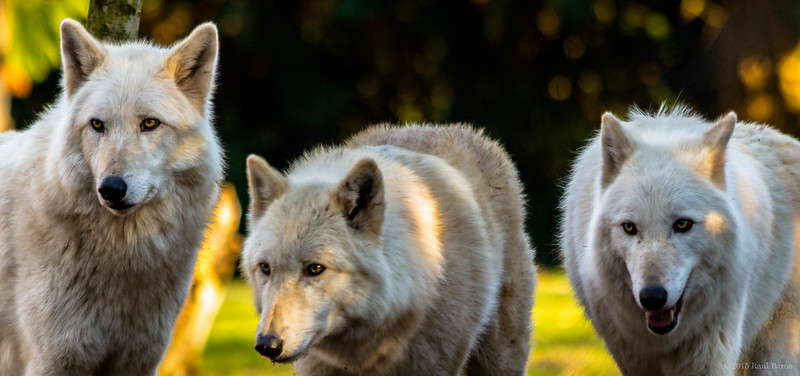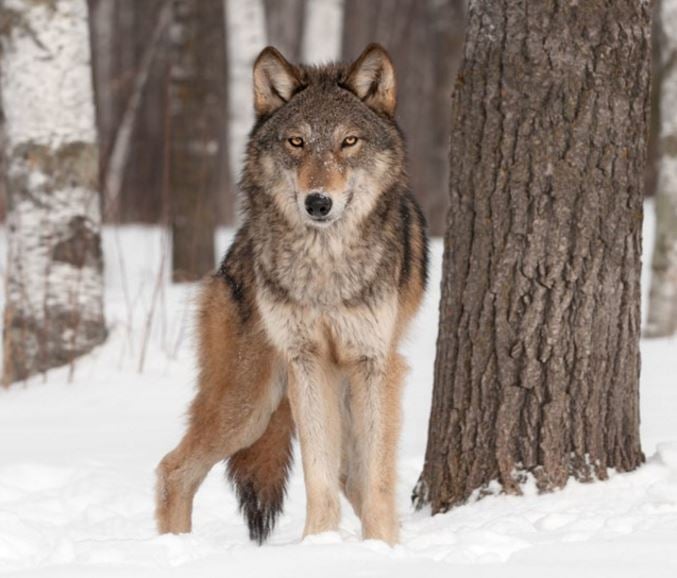


SALEM, Ore.— ODFW has confirmed five livestock depredation incidents on private land within the past three weeks by some wolves in the Imnaha pack, despite continued efforts by ODFW, Wallowa County officials, and area livestock producers to deter wolf-livestock conflict with non-lethal measures. With the pack now involved in chronic livestock depredation and as part of implementation of Oregon Wolf Conservation and Management Plan provisions, ODFW will lethally remove depredating wolves to reduce the likelihood of further losses. Information from two collared wolves--OR4, the alpha male and OR39, the alpha female--indicate that they and another two younger wolves have regularly used an area of private land on the westernmost portion of their known home range. While infrequent visits were historically made to the area by this pack, the near continual use of the area at this time of year is a marked departure from the pack’s normal pattern. Coinciding with this changed pattern, ODFW documented livestock depredation by the pack in investigations on March 9, March 25, two more (see report 1 and 2) on March 28 and one more on March 30. ODFW received a lethal order request after the March 9 depredation, but did not authorize it. At that time, the Imnaha Pack had not been involved in depredation since the previous October and ODFW didn’t characterize the situation as chronic. That changed when the pack killed or injured livestock in four additional incidents over the past week, bringing the total to six separate incidents within five months. ODFW received another lethal order request after the March 25 depredation. “Unfortunately members of the Imnaha wolf pack are once again involved in chronic livestock depredation, and ODFW is adhering to the Plan and protecting the interests of area livestock producers,” said Russ Morgan, ODFW wolf coordinator. “Spring is typically the time when depredation increases. Even more cattle and sheep will be on these private lands soon as calving and lambing season continues, increasing the risk for even more losses from this group of depredating wolves.” Under the rules associated with the Wolf Plan in Phase II, ODFW can authorize lethal control of wolves at a property owner or permittee’s request if a) the agency confirms at least two depredations on livestock in the area; b) the requester has documented unsuccessful attempts to solve the situation through non-lethal means; c) no identified circumstance exists that attracts wolf-livestock conflict; and d) the requester has complied with applicable laws and the conditions of any permit. In the current Wallowa County situation, non-lethal measures were being used when the depredations occurred and there were no bone piles or other attractants present. The preventive measures for the sheep producer included midnight spotlighting, three livestock protection dogs with the sheep 24 hours per day, three-per-day checks of livestock and a range rider patrolling the area and hazing the wolves when found. For cattle, delayed pasture rotation to keep animals closer to a public road, pasturing yearlings with cows, frequent checks in association with calving cattle, and patrolling/hazing by a range rider were used. While ODFW documented eight wolves in the Imnaha Pack for 2015, the department believes the pack has grown and that four of the wolves (the alpha male and female and two younger wolves) have separated from the rest of the pack. These four have been travelling together in this area and are associated with the four recent depredations on private land. Meanwhile, other members of the pack have been spending time in an area separated from the four depredating wolves. They are not known to be involved in the chronic depredation patterns and are not subject to the lethal control order. ODFW will focus lethal control efforts on the wolves linked to the depredations. Morgan believes the Imnaha group of wolves could be splitting up and that age and physical condition may be playing a role in the depredation. The alpha male is nearly 10 years old and the alpha female has been known to limp since she first appeared a few years ago. “As wolves grow old, or if they are injured, they are unable to hunt traditional wild prey as they have in the past,” said Morgan. “This could be playing a role in the pack’s recent behavior.” This will be the third time ODFW has used lethal control for wolves since they returned to the state in the early 2000s. Two wolves were killed after a number of losses in Baker County in 2009, and two wolves from the Imnaha pack were removed in 2011 due to chronic livestock depredation. Despite today’s announcement, Oregon’s wolf population as a whole is growing. ODFW documented 110 known wolves at the end of 2015, a 36 percent increase over 2014. “This is the tough part of the job, but we believe lethal control is the right decision in this situation,” continued Morgan. “Wildlife managers must strike a balance between conserving wolves and minimizing impacts on livestock. This action in response to this situation will not affect the continued positive wolf population growth we are seeing across Oregon.” For more information on wolves, visit www.dfw.state.or.us/wolves
###
|
|||
| Contact: | Michelle Dennehy or Richard Hargrave Oregon Fish and Wildlife Michelle.N.Dennehy@state.or.us or Richard.J.Hargrave@state.or.us (503) 947-6022 or (503) 947-6020 source | ||


| Researchers at the USGS Northern Rocky Mountain Science Center and
their partners place thermal remote cameras near deer and elk carcasses
in Yellowstone National Park to capture images of wolves with mange
feeding in the wild. Red-colored blotches in the thermal images reveal
areas of hair loss from which wolves with mange lose heat. Researchers
at the USGS Northern Rocky Mountain Science Center and their partners
place thermal remote cameras near deer and elk carcasses in Yellowstone
National Park to capture images of wolves with mange feeding in the
wild. Red-colored blotches in the thermal images reveal areas of hair
loss from which wolves with mange lose heat. Using a remotely triggered thermal camera to capture vivid and colorful images, scientists gathered body temperature data from mange-infected gray wolves in Yellowstone National Park and compared that to a sample group of healthy captive wolves with shaved patches of fur to simulate mange-induced hair loss. Using these data, scientists were able to quantify the level of heat loss, or energetic costs, during the winter months. Results show that a more severe mange infection could increase heat loss by around 1240 to 2850 calories per night which represent roughly 60-80 percent of the average wolf’s daily caloric needs. “That lost heat has to be replaced, otherwise the wolves’ core body temperatures would be getting colder,” said Paul Cross, USGS ecologist and lead author of the study. “To replace that lost heat wolves would need the equivalent of about two to four extra pounds of elk meat per day.” Sarcoptic mange, present in one of 10 known packs in Yellowstone as of 2015, is a skin disease caused by a mite that burrows into the skin, causing irritation and scratching that then leads to hair loss. Researchers engineered the remotely-triggered thermal camera for use in Yellowstone to record the surface temperatures of wolves with and without mange-induced hair loss. Those images could then be compared with images from healthy, captive wolves. In addition, field crews observed or photographed all radio-collared wolves and their pack mates for the purpose of recording infection status. The study also found that increased wind speed was a more significant factor in heat loss than colder temperatures. To compensate for the extra heat loss, infected wolves would need to increase food consumption in addition to other daily energy demands for survival. For wolves with mange this is more difficult as hair loss and depressed vigor leaves them vulnerable to hypothermia, malnutrition and dehydration, which can eventually lead to death. Data from GPS-collared wolves in Yellowstone indicated that wolves with mange reduce daily movement distances depending on the degree of infection. In addition, the wolf with the most hair loss became more active during the day than during the twilight hours, which is opposite behavior of a healthy wolf. “By definition, parasites drain energy from their hosts. In this study we estimated just one portion of the energetic costs of infection,” said Cross. “Even when parasites do not kill their hosts they are affecting the energy demands of their hosts, which could alter consumption rates, food web dynamics, predator-prey interactions and scavenger communities.” Mange was introduced into the Northern Rockies in the early 1900s by the Montana state wildlife veterinarian in an attempt to help eradicate local wolf and coyote populations. The disease persists in coyotes and foxes and once wolves were reintroduced into the ecosystem in 1995-96, they appeared to be free of mange until 2002. The article “Energetic costs of mange in Yellowstone wolves estimated from infrared thermography” is published in Ecology. The study is a collaborative effort between the USGS, Pennsylvania State University, University of Western Australia, Yellowstone National Park, University of Wollongong, NWB Sensors Inc. and Montana State University. More information about wolf disease studies can found on the USGS Northern Rocky Mountain Science Center website.
|















 The ornate dome over the Idaho House chamber shines with the March light (Betsy Z. Russell)
The ornate dome over the Idaho House chamber shines with the March light (Betsy Z. Russell)

 "Unlike humans, wolves do not kill for sport," writes the Idaho-based advocacy group Living With Wolves.
Instead, the animals are often chased off their kills, either by other
predators or by people, who often don't even realize they are
approaching them.
"Unlike humans, wolves do not kill for sport," writes the Idaho-based advocacy group Living With Wolves.
Instead, the animals are often chased off their kills, either by other
predators or by people, who often don't even realize they are
approaching them.